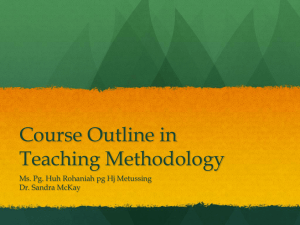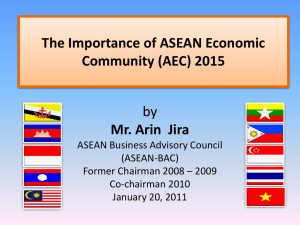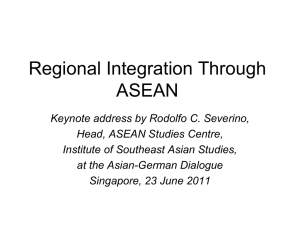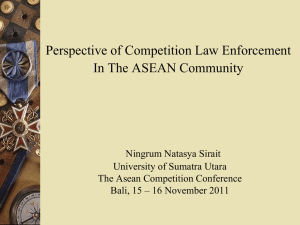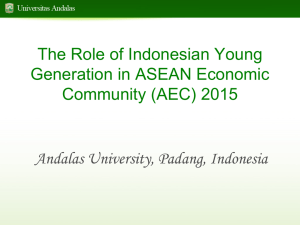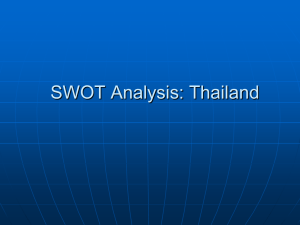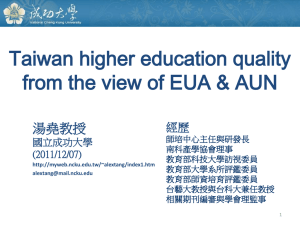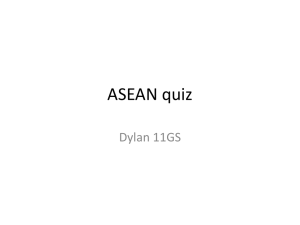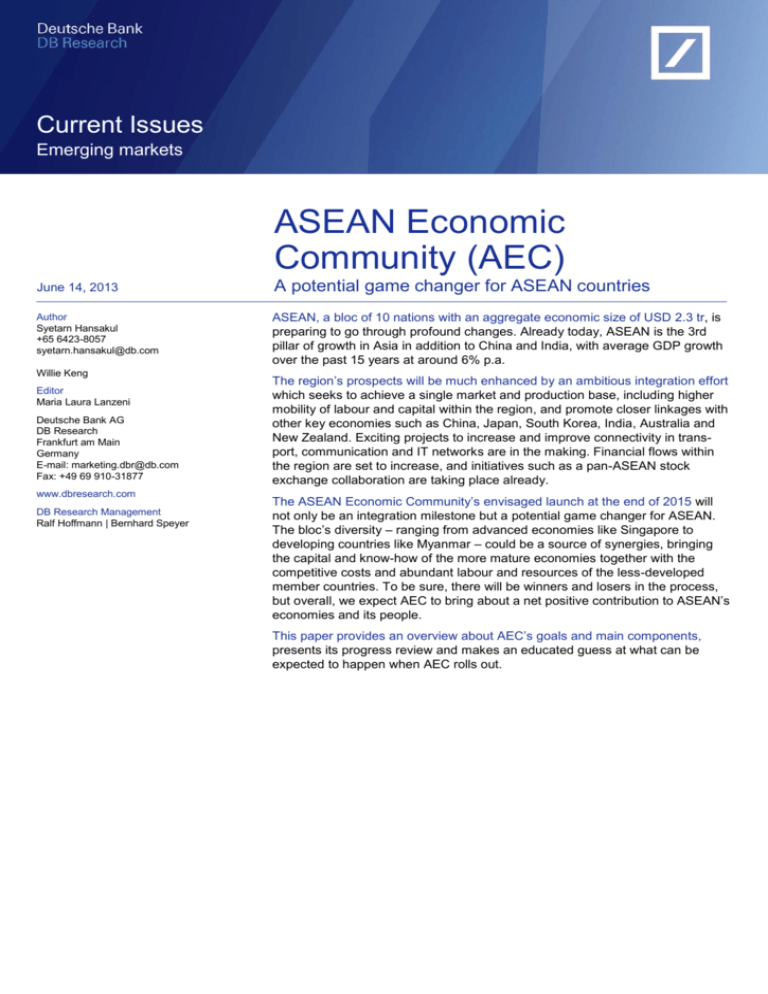
Current Issues
Emerging markets
ASEAN Economic
Community (AEC)
June 14, 2013
A potential game changer for ASEAN countries
Author
Syetarn Hansakul
+65 6423-8057
syetarn.hansakul@db.com
ASEAN, a bloc of 10 nations with an aggregate economic size of USD 2.3 tr, is
preparing to go through profound changes. Already today, ASEAN is the 3rd
pillar of growth in Asia in addition to China and India, with average GDP growth
over the past 15 years at around 6% p.a.
Willie Keng
Editor
Maria Laura Lanzeni
Deutsche Bank AG
DB Research
Frankfurt am Main
Germany
E-mail: marketing.dbr@db.com
Fax: +49 69 910-31877
www.dbresearch.com
DB Research Management
Ralf Hoffmann | Bernhard Speyer
The region’s prospects will be much enhanced by an ambitious integration effort
which seeks to achieve a single market and production base, including higher
mobility of labour and capital within the region, and promote closer linkages with
other key economies such as China, Japan, South Korea, India, Australia and
New Zealand. Exciting projects to increase and improve connectivity in transport, communication and IT networks are in the making. Financial flows within
the region are set to increase, and initiatives such as a pan-ASEAN stock
exchange collaboration are taking place already.
The ASEAN Economic Community’s envisaged launch at the end of 2015 will
not only be an integration milestone but a potential game changer for ASEAN.
The bloc’s diversity – ranging from advanced economies like Singapore to
developing countries like Myanmar – could be a source of synergies, bringing
the capital and know-how of the more mature economies together with the
competitive costs and abundant labour and resources of the less-developed
member countries. To be sure, there will be winners and losers in the process,
but overall, we expect AEC to bring about a net positive contribution to ASEAN’s
economies and its people.
This paper provides an overview about AEC’s goals and main components,
presents its progress review and makes an educated guess at what can be
expected to happen when AEC rolls out.
ASEAN Economic Community
ASEAN-10 at a glance (2012)
DX
Sources: IMF, DB Research
2
| June 14, 2013
Current Issues
ASEAN Economic Community
ASEAN population in comparison to
China and India
1
ASEAN (Association of Southeast Asian Nations), established in 1967, is a
large economic bloc in Asia. Comprising 10 countries – Brunei Darussalam,
Cambodia, Indonesia, Lao People’s Democratic Republic, Malaysia, Myanmar,
Philippines, Singapore, Thailand and Vietnam –, the region boasts a population
of over 600 million (chart 1), roughly half that of China’s or India’s and around
9% of the world’s total. ASEAN’s economic weight is also substantial, with a
GDP of USD 2.3 trillion in 2012 – around 30% the size of China’s, roughly the
same size as that of the UK and 25% larger than India’s. Its GDP accounts for
1
3% of the world’s total .
Population, million persons
1,400
1,200
1,000
800
600
400
200
0
1992
ASEAN-10
2002
China
2012
India
Source: IMF
ASEAN economic growth
2
Real GDP growth, % yoy*
ASEAN: A region in need of investment
*Simple average of ASEAN countries
Source: IMF
ASEAN current account turnaround after
1997 crisis
3
Current account balance
120
100
80
60
40
20
0
-20
-40
12
10
8
6
4
2
0
-2
-4
90 92 94 96 98 00 02 04 06 08 10 12
USD bn (left)
% of GDP (right)
ASEAN is a middle-income region. Nominal per-capita GDP of the five ASEAN
founding members (or ASEAN-5: Indonesia, Malaysia, Philippines, Singapore
and Thailand) was USD 4,500 in 2011, slightly lower than China’s USD 5,400.
Taking into account the 10 members, ASEAN’s GDP per capita was USD 3,600.
Income levels among ASEAN member countries are hugely diverse. Countries
such as Singapore and Brunei enjoy a very high GDP per capita at around USD
49,000 and USD 39,000, respectively, on par with the top tier of developedmarket economies. In contrast, Myanmar and Cambodia have a GDP per capita
of just below USD 900.
ASEAN growth was very robust over the past two decades, except around the
time of the Asian financial crisis in 1997-98 and the global financial crisis in
2008-09. For the next few years we expect ASEAN’s annual real GDP growth to
reach around 6% (chart 2).
12
10
8
6
4
2
0
-2
-4
1990 1993 1996 1999 2002 2005 2008 2011
Source: IMF
Introduction
During the 1990s, the investment/GDP ratio was 30%-40% in the ASEAN-5
countries, except in the Philippines. Investment exceeded domestic savings, as
manifested in substantial current-account deficits, funded to a large extent by
“hot money”. This changed abruptly after the 1997 financial crisis (chart 3).
Current-account balances turned to surplus mostly at the expense of domestic
investment, which dropped to 20%-30% of GDP.
In comparison, China and India were much less affected by the Asian financial
crisis, and their domestic investment activity remained strong. In the case of
China, investment has been funded by a vast pool of domestic savings and
huge FDI inflows. India, by contrast, does not have sufficient domestic savings
to fund its investment needs, but it managed to increase FDI inflows almost
eightfold from 2003-2011.
Having adjusted its external balances and become an “excess savings” region,
ASEAN now needs to increase domestic investment in order to lift its potential
rate of growth. Among other things, ASEAN countries would benefit from
savings being channelled to intra-regional investment. To be sure, this is
already happening: intra-ASEAN FDI rose from 14% of total FDI during 2002-09
to 18.5% in 2009-11 (chart 4), overtaking the EU’s share of 17%. With the EU
still beset by the Eurozone debt crisis, the role of intra-ASEAN FDI flows is even
more significant. The share of other traditional sources of FDI to ASEAN such
as Japan (12%) and the US (10%) also saw a decline during 2009-2011.
1
3
| June 14, 2013
On a purchasing power parity (PPP) basis, ASEAN’s global share was 4.3% in 2012 (vs 3.3% in
1992 and 3.7% in 2002).
Current Issues
ASEAN Economic Community
Intra-ASEAN FDI rising but still small
4
A case for further facilitating investment flows
USD bn
100
80
60
40
20
0
2000
2002
2004
2006
2008
2010
Intra-ASEAN FDI flows
Extra-ASEAN FDI flows
Sources: ASEANstats, ASEAN Secretariat
AEC could enhance trade openness for
some ASEAN economies
5
Trade/GDP ratio 2012
Singapore
Vietnam
Cambodia
Malaysia
Thailand
Brunei
Lao PDR
Myanmar
Philippines
Indonesia
Investment liberalisation and the promotion of intra-regional flows also serve to
enhance the region’s attractiveness to global investors. For example in the case
of the EU, the formation of the Single Market led to the gradual increase in its
share of global FDI inflows from 34% during 1980-1992 to 41% during 19932
2007 . In ASEAN, early investment liberalisation measures were effective but
they need to be supplemented with new measures to maintain the region’s
attractiveness. The 1992 ASEAN Investment Agreement (AIA) and ASEAN
Investment Guarantee Agreement (IGA) were effective in increasing global
inflows into ASEAN until the Asian financial crisis. Its share of global FDI inflows
rose to around 7% during 1992-1997 from 5% during 1980-1991. It then saw a
slide to 4% during 1998-2009, which, among other factors, might suggest a lack
of improvement in the region's investment framework. In 2009, a new and
enhanced ASEAN Comprehensive Investment Agreement (ACIA) replaced the
previous AIA and IGA frameworks. Industries including manufacturing,
agriculture, fishery, forestry & mining and quarrying are now required to grant
national treatment to foreign investors. Following the revamped agreements, the
region saw a jump in its share of global FDI inflows to around 7.5-8% in
2010-11.
Intra-regional trade boosted by the most open ASEAN countries
0%
100%
200%
300%
Source: IMF
Wide gap among ASEAN countries'
logistics standards
6
Myanmar
Laos
Cambodia
Indonesia
Vietnam
Philippines
Thailand
Malaysia
Singapore
0
50
100
150
Ranking (out of 155); 1 = best
Sources: LPI ranking and scores, 2012, World Bank
ASEAN top 10 export markets
(2011)
Australia
3.2%
Korea,
Rep.
4.4%
7
Taiwan
2.8%
India
3.6%
Hong
Kong
6.5%
IntraASEAN
25.0%
United
States
8.5%
Japan
10.3%
China
11.5%
EU-27
10.6%
ASEAN is a substantial trading bloc with a merchandise trade value of USD 2.4
trillion (as of 2011), 25% of which is intra-regional trade. Intra-ASEAN exports
amounted to USD 328 bn in 2011, 26% of total exports. Intra-ASEAN imports
totalled USD 271 bn, or 24% of total imports.
ASEAN’s trade openness is high, at 110% of GDP. Among its members,
Singapore has the by far highest trade-to-GDP ratio, at close to 300% of GDP.
Malaysia and Thailand have trade-to-GDP ratios way above 100% (chart 5). All
three countries are tightly integrated into regional and global manufacturing
supply chains. Moreover, they have high standards in trade logistics: the World
Bank’s Logistics Performance Index (LPI) places Singapore, Malaysia and
Thailand at the top of ASEAN (chart 6). It is thus not by co-incidence that these
3
countries have been the most active contributors to intra-regional trade .
Vietnam, Cambodia, Brunei and Laos have seen their trade-to-GDP ratios rise
strongly in recent years to around 100% of GDP, indicating an increasing
openness, but the contribution to intra-regional trade remains small. Indonesia,
Philippines and Myanmar still have a relatively low trade-to-GDP ratio of below
100%, suggesting plenty of headroom to increase openness.
China has become ASEAN’s main trading partner
Integration efforts and global developments have shifted the pattern of ASEAN
countries’ international trade. The share of the bloc’s trade with the US, the EU
and Japan has declined markedly over the past two decades or so. In 2011,
ASEAN trade with the US accounted for 8.5% of the total (vs 18% in 1993), with
the EU-27 for 10.6% (15% in 1993), and with Japan for 10.3% (20% in 1993)
(chart 7). China has emerged as the No. 1 trading partner for ASEAN, with its
share rising to 12% in 2011 vs just 2% in 1993. The rise in ASEAN-China trade
provides evidence of the role of China in the Asian supply-chain networks. In
2011, 11% of ASEAN’s exports went to China and 13% of ASEAN imports came
from China. ASEAN consistently ran a trade surplus with the US and EU but a
2
Sources: ASEANstats, ASEAN Secretariat
4
| June 14, 2013
3
Includes inflows to all 27 EU countries.
Singapore, Malaysia and Thailand contribute 41.3%, 18.2% and 17.3%, respectively, of total
intra-regional exports.
Current Issues
ASEAN Economic Community
ASEAN top 10 import markets
(2011)
Saudi
Arabia
3.1%
Germany
2.5%
UAE
2.8%
Taiwan
4.0%
India
2.2%
IntraASEAN
23.9%
Korea,
Rep.
6.1%
United
States
7.9%
8
China
12.8%
EU-27
9.5%
Sources: ASEANstats, ASEAN Secretariat
trade deficit with China, suggesting a supply-chain pattern in which ASEAN
imports parts from China and exports the final product to the US and the EU.
Trade patterns reflect product specialisation and rising domestic consumption in
ASEAN countries
The majority of the region’s trade reflects the specialisation in electronics, heavy
machinery, vehicles and parts, chemicals, plastics and processed raw materials
such as oil and rubber (chart 9). ASEAN exports to China include commodities
such as rubber, oil, coal and palm oil in addition to electronic integrated circuits
(ICs). Exports to the US and EU are dominated by electronics and machinery
and natural rubber. The trade pattern reflects of the significance the US and the
EU as final consumers of electronic products and China’s important role as a
commodities import market.
Intra-ASEAN trade has seen an uptrend in trade of final consumer goods, which
is an encouraging sign of the growing importance of domestic consumption
within ASEAN. According to the IMF, “the increasing role of intraregional trade in
final consumption goods, together with a large domestic market, especially in
Indonesia, appears to provide the region with a potential source of resilience
4
against global demand shocks” .
9
Top 10 ASEAN exports by products (2011 )
Electronics,
electrical machinery
20.2%
Precious stones,
jewelery
2.1%
Others
27.8%
Mineral fuels, oils
18.4%
Vehicles & parts
2.5%
Organic chemicals
Plastics & articles
3.0%
3.0%
Animal/vegetable
oils & products
3.8%
Rubber & articles
4.2%
Business services &
misc. repairs
4.1%
Nuclear reactors,
machinery &
appliances
10.9%
Sources: ASEANstats, ASEAN Secretariat
Top 10 ASEAN imports by products (2011)
Optical,
medical/surgical
instruments
2.0%
Others
26.5%
10
Mineral
fuels, oils
21.9%
Organic chemicals
2.2%
Business services &
misc. repairs
2.8%
Precious, jewelry
2.9%
Electronics,
electrical machinery
& parts
19.3%
Vehicles & parts
3.0%
Machinery &
mechanical
Plastics & articles
appliances
3.1%
Iron & steel 12.7%
3.5%
Sources: ASEANstats, ASEAN Secretariat
4
5
| June 14, 2013
IMF World Economic and Financial Surveys, Regional Economic Outlook, Asia and Pacific:
Shifting Risks, New Foundations for Growth, April 2013.
Current Issues
ASEAN Economic Community
What is the ASEAN Economic Community?
ASEAN Economic Community (AEC) is the end-goal of the bloc’s economic
5
integration as espoused in its “Vision 2020”. The latter was articulated in 1997
by the ASEAN heads of state, in the aftermath of the eruption of the Asian
financial crisis, seeking to create a stable, prosperous and highly competitive
economic region.
The decision to establish the ASEAN Economic Community was affirmed by the
Declaration of ASEAN Concord II in Bali, Indonesia, in 2003. The Declaration
came not long after China joined the WTO and India emerged as an investment
and offshore location for multinational corporations. The rise of the emerging
markets, in particular the BRIC, appears to have given ASEAN leaders the
impetus to do something to keep the region under investors’ radar.
The launch of AEC is currently planned for the end of 2015. The start date was
initially set for 2020 and subsequently moved forward to January 1, 2015. In
November 2012, ASEAN leaders agreed to move the launch date again to
December 31, 2015 in order to give member states more time to prepare for
necessary regulatory changes.
AEC Blueprint’s vision and goals
AEC was further boosted by the adoption of the AEC Blueprint in Singapore in
2007. The Blueprint stipulates the vision, goals and strategic schedule,
envisaging four key characteristics for the Economic Community:
1) A single market and production base. In short, barriers to trade in goods and
services will be brought down or kept to a minimum. Flows of investment, capital
and skilled labour will be facilitated and co-operation in sectors designated as
priority integration sectors will be promoted.
— Free flow of goods
— Free flow of services
— Free flow of investment
— Freer flow of capital
— Free flow of skilled labour
— Priority integration sectors
— Food, agriculture and forestry
2) A competitive economic region. To promote ASEAN as a competitive
economic bloc, it is important to have a regional standard in trade policy and for
the business operating environment. This pillar seeks to address the following
areas to enhance the region’s competitiveness to investors:
— Competition policy
— Consumer protection
— Intellectual property rights
— Infrastructure development
— Taxation
— E-commerce
5
6
| June 14, 2013
The other two integration pillars are the Security Community and the Socio-Cultural Community.
Current Issues
ASEAN Economic Community
3) Equitable economic development. ASEAN member states will strive to level
the playing field as much as possible. In this regard, two areas will be under
focus:
— SME development
— Initiative for ASEAN integration (IAI). Its objectives are to narrow the
development gap between members and to accelerate economic integration
of the newer members, namely Cambodia, Lao PDR, Myanmar and
Vietnam (CLMV)
4) Integration into the global economy. ASEAN strives to integrate itself better
as a bloc into the global supply chain. For this purpose, two main lines of action
are pursued:
— Coherent approach regarding external economic relations
— Enhanced participation in global supply networks
AEC organisation and main agreements
ASEAN progress thus far has been driven by consensus based on the
agreements by the Heads of State and subsequent action plans. No special
organisation has been set up to support the establishment of the AEC. The
ASEAN Economic Ministers (AEM) group is accountable for the overall
implementation of the Blueprint. Relevant ASEAN sectoral bodies are
responsible for the implementation of programmes and measures. At the
national level, government agencies are responsible for overseeing
implementation and preparing more detailed action plans. Partnerships with the
private sector, industry associations and the community in general are urged to
6
ensure participation of all stakeholders. The Secretary-General of ASEAN is
responsible for reporting the progress of AEC to ASEAN ministerial meetings
and the ASEAN Summit.
To date there have been numerous agreements in the run-up to the AEC.
Among the key agreements are:
ASEAN Connectivity: Key elements
11
Physical connectivity
— Transport
— Information and Communications
Technology (ICT)
— Energy
Institutional connectivity
— Trade liberalisation and facilitation
— Investment and service liberalisation
and facilitation
— Mutual recognition agreements/
arrangements
— Regional transport agreements
— Cross-border procedures
— Capacity-building programmes
People-to-people connectivity
— Education and culture
a) Master Plan on ASEAN Connectivity (chart 11): The plan strives to make
production and distribution networks in ASEAN deeper, wider, and more
entrenched in the East Asian and global economy. It provides a 3-pronged
strategy:
— Physical connectivity through enhanced physical infrastructure
development;
— institutional connectivity through effective institutions, mechanisms and
processes;
— people-to-people connectivity by providing education, promoting tourism,
etc.
Examples of projects to enhance ASEAN connectivity include the ASEAN
Highway Network and high-speed railways between Malaysia and Singapore.
The ASEAN Infrastructure Fund was established with the Asian Development
Bank to fund physical infrastructure projects in ASEAN.
b) ASEAN Trade in Goods Agreement (ATIGA): Its key objective is to achieve a
free flow of goods in ASEAN as a means to establish a single market and
production base. ATIGA seeks to eliminate non-tariff barriers and implement the
cross-border ASEAN Trade Facilitation Work Program (ATFWP). The ATFWP in
— Tourism
Source: Master Plan on ASEAN Connectivity
7
| June 14, 2013
6
ASEAN’s Secretariat is located in Jakarta. The current Secretary-General (2013-2017) is
H.E. Le Luong Minh. For more details see www.asean.org.
Current Issues
ASEAN Economic Community
turn seeks to simplify the rules of origin, harmonise product standards and
regulations and carry out customs integration. The ASEAN Single Window
(ASW) is intended to streamline and synchronise the processing of data and
information, creating a single decision-making point for customs release and
clearance. Successful implementation of ATFWP will reduce transaction costs
and time, accelerating the movement of goods within ASEAN and facilitating
access to raw materials, labour and technology from various parts of the region.
There are numerous agreements with regard to other areas of cooperation such
as investment, capital markets, aviation, etc. Implementation of the agreements
is done by consensus; there is no enforcement of penalty for non-compliance.
ASEAN Economic Community (AEC):
Progress report
12
Single market and production base
— ASEAN-6* have applied 0% tariff on
99% of goods
— CLMV are trading 98.6% of goods at
0-5% tariff rates
— National Single Windows
implemented in IDN, PHL, SGP, THA
— Some progress in services trade and
investment liberalisation
— ASEAN Exchange took off: MYS,
SGP, THA
— Mutual Recognition Arrangements
(MRAs) for skilled professionals in
progress
Competitive economic region
— Master Plan on ASEAN Connectivity
adopted in 2010
— ASEAN Infrastructure Fund
established with the ADB to promote
physical infrastructure. Private-public
partnership encouraged for infrastructure projects
Equitable economic development
Progress report: How far has AEC advanced?
A Mid-Term Review of the implementation of the AEC Blueprint was conducted
by the Economic Research Institute for ASEAN and East Asia (ERIA). The Mid7
Term Review’s Executive Summary was published in October 2012 (chart 12)
Progress with the implementation of AEC measures is noted in the following
areas:
— Lowering of goods tariffs. This is a continuation of the ASEAN Free Trade
Area (AFTA) Agreement introduced in 1992, which had sought to achieve
Common Effective Preferential Tariffs (CEPT), gradually reducing and
eliminating tariffs to 0-5% for each member country. CEPT rates are virtually
zero in ASEAN-5 and Brunei. For Cambodia, Laos, Myanmar and Vietnam
the CEPT average rate was 2.6% in 2010.
— Trade facilitation. The ASEAN-5 countries have achieved live
8
implementation of the National Single Windows , although a full roll-out is
still pending. Brunei and Vietnam are in an advanced stage toward live
implementation by 2015.
— Investment liberalisation (goods sector). Commitments in the goods sector –
under the ASEAN Comprehensive Investment Agreement (ACIA) – are
already liberal in most ASEAN member countries, according to the benchmark of 70% permissible foreign ownership.
— Free Trade Agreements. Five “ASEAN+1” FTAs were signed, with China,
Japan, Korea, India and Australia/New Zealand. Negotiations are ongoing
for services and investment agreements with Japan and India.
nd
— 2 phase of Initiative for ASEAN
Integration (IAI) work plan (20092015): Developed ASEAN states to
help less developed ASEAN states in
7 priority projects: infrastructure
development, human resources
development, ICT development,
capacity building, tourism, poverty
and quality of life
Integration into global economy
— ASEAN-China FTA
— ASEAN-Korea FTA
— ASEAN-CER (Australia, New
Zealand) FTA
— ASEAN-India trade in goods
agreement
— Air transport. A number of air transport agreements have been signed under
the ASEAN-X formula. The ASEAN-X formula gives the flexibility for ASEAN
member states to sign agreements with one another without having to
include members which are not yet ready. The success of the air transport
agreements gives rise to hopes that the ASEAN-X formula could be
replicated to forge forward other parts of the regional agenda.
— Monetary cooperation. The signing and implementation of the Chiangmai
Initiative is a notable development. Signatory countries agree to pool their
foreign-exchange resources to provide liquidity to member countries in
times of emergency through bilateral swap arrangements. The Chiangmai
Initiative is but one example of institutional mechanisms and arrangements
at the ASEAN+3 level that increase the region’s ability to respond to a crisis.
7
* Brunei, Indonesia, Malaysia, the Philippines, Singapore,
Thailand
Sources: Mid-Term Review of the Implementation of AEC
Blueprint, ERIA; DB Research
8
| June 14, 2013
8
Mid-Term Review of the Implementation of AEC Blueprint Executive Summary, October 2012,
Economic Research Institute for ASEAN and East Asia (ERIA), Jakarta.
A facility that allows the parties involved in trade and transport to lodge standardised information
and documents with a single entry point to fulfill all import, export, and transit-related regulatory
requirements.
Current Issues
ASEAN Economic Community
The establishment of the ASEAN+3 Macroeconomic Research Office also
enhances the region’s surveillance and co-ordination efforts.
— Free flow of skilled labour. Mutual Recognition Arrangements (MRAs) for
skilled professionals will cover 7 professions: doctor of medicine, dentist,
nurse, engineer, architect, accountant and surveyor. The aim is for
professional qualifications in these fields to be recognised in other ASEAN
member states, facilitating flows of skilled labour within ASEAN. According
to the Mid-Term Review findings, MRAs on engineers and architects are
underway to full implementation, with regional and national systems in
place. A few ASEAN countries already made recommendations for regional
accreditation.
— Capital markets. The ASEAN Exchange, a collaboration of the seven stock
9
exchanges of ASEAN , kicked off in September 2012 with the live roll-out of
the ASEAN Trading Link, connecting Bursa Malaysia and the Singapore
Exchange. The Stock Exchange of Thailand joined in October 2012. The
system currently uses an electronic order routing system that allows brokers
from the three exchanges to connect their clients to trading on the
exchanges of the other countries. The potential for ASEAN capital market
collaboration is huge. In 2010, aggregate gross domestic savings of ASEAN
nations amounted to USD 616 billion, with the largest contributions coming
from Indonesia, Singapore and Thailand. To facilitate the mobility of savings
across national borders, the AEC has put in place standardised offering and
distribution rules and disclosure requirements, as well as an enhanced
withholding tax structure to attract cross-border investors in debt paper, with
a view to lowering transaction costs and exploiting economies of scale.
AEC scorecard
13
Score out of 100
ASEAN
Pillar I:
Economic
Single
Community market
production
base
Pillar II:
Competitive
economic
region
Pillar III:
Equitable
economic
development
Pillar IV:
Integration
into
global
economy
68.2
69.2
66.7
85.7
66.5
Sources: ASEAN Economic Community Scorecard, ASEAN
Secretariat, 2012
ASEAN has established a monitoring mechanism called the AEC Scorecard to
ensure timely implementation of the AEC initiatives. The AEC Scorecard reports
progress with implementing the various AEC measures. According to the latest
AEC Scorecard published in March 2012, the overall score is 68.2 (out of 100)
(chart 13). Among the four pillars, Pillar IV, Integration into Global Economy, has
made the most progress, scoring 85.7. Pillar I, Single Market and Production
Base, has the lowest score of 66.5. The score appears to suggest that
challenges with regard to non-trade barriers remain considerable and have yet
to be tackled to create a smooth-functioning single market and production base.
AEC final lap: Remaining tasks
It is now less than three years before the expected AEC launch at end-2015. A
lot of work remains to be done to achieve a credible and meaningful start.
Progress in the following areas would be especially helpful:
— Non-trade barriers (NTBs) and non-tariff measures (NTMs). Non-tariff
barriers and non-tariff measures such as safety and health regulations or
technical barriers remain obstacles to the free flow of trade in both goods
and services. One recommendation put forward in the mid-term review is to
address the non-trade barriers and non-tariff measures systematically
through the set-up of a comprehensive database of NTMs in ASEAN. The
database could then be the starting point for member countries to negotiate
and reduce NTBs and NTMs in an efficient and systematic manner.
— Trade and investment facilitation. Although several countries have started
implementing National Single Windows (NSW), customs and logistical
integration still has some way to go. A wide gap still exists in terms of the
9
9
| June 14, 2013
These are the Singapore Exchange, Bursa Malaysia, Hanoi Stock Exchange, Ho Chi Minh Stock
Exchange, Indonesia Stock Exchange, The Philippine Stock Exchange and The Stock Exchange
of Thailand.
Current Issues
ASEAN Economic Community
number of days needed to carry out exports and imports, with the highest
number registered in Laos (45 days) and the lowest in Singapore (3 days),
according to World Bank data on trading across borders. For example, it
would be beneficial if ASEAN countries agreed and accepted standardised
business processes and harmonised data for electronic exchange under an
ASEAN Single Window (see page 8). As for investment facilitation, further
process streamlining and more inter-agency co-operation within each
country and among member states have been recommended.
— SME development. The corporate sector in many ASEAN economies is
dominated by large government-linked companies or multinational
corporations (MNCs). The potential of small and medium-sized enterprises
is underutilised, often due to a lack of investment and technical know-how.
Helping SMEs in terms of trade and investment facilitation and technological
development would make the AEC’s impact on member countries more farreaching.
— Public-private sector partnership. Thus far, the public impression of AEC is
that it is driven by the government sector, which needs to be corrected.
While the AEC concept was drawn up by the countries’ leaders and the
government has a key role in providing a conducive legal and business
environment, AEC success depends crucially on private-sector involvement
and public support. In this regard, greater efforts should be made to raise
awareness of AEC among the business community to bring it on board.
There should be regular public-private consultation forums for brainstorming
and strategy sessions.
10 | June 14, 2013
Current Issues
ASEAN Economic Community
Conclusion
When the AEC officially comes into effect on December 31, 2015, it will mark a
significant milestone of ASEAN member countries’ commitment to come and
work together as an economic bloc. While it would be unrealistic to expect a
smoothly functioning economic community right from the start, the AEC
framework could lift the sense of solidarity and ultimately business and
consumer confidence. The AEC will still be a work in progress and should be
perceived in that light. It is also important to recognise that a regional network
will not cure domestic economic ills. Different countries and different sectors will
see different effects.
A potential negative impact could be fiercer competition and wage constraints
for low-skilled workers in high-cost (high-income) countries, similar to what bluecollar workers in the US and EU have faced in the wake of globalisation. For
small businesses in the high-cost countries, more competition could also bring
about a squeeze in profit margins. For small countries, a sudden surge in capital
inflows can be overwhelming and lead to high inflation, bubble risks, a boombust cycle and stress for the banking sector. Measures should thus be prepared
to help potentially affected workers (i.e. expanding social security nets and
training) and, in the smaller economies, to build institutions to cope with the new
economic paradigm.
Those that stand to gain from the AEC are companies that already have a
regional or global network, as the ease of moving goods, capital and labour
around will reduce costs and save time and thus enhance productivity.
Educated workers from lower-wage countries are likely to be in demand in the
initial stage. Job creation is expected to be strong in the lower-wage countries.
The financial sector is another clear winner. Increasing trade and investment
flows spell more business for financial institutions. Overall, we expect the AEC
to bring about a net positive contribution to ASEAN members’ economic growth
and the welfare of its people.
Syetarn Hansakul (+65 6423-8057, syetarn.hansakul@db.com)
Willie Keng
11 | June 14, 2013
Current Issues
Emerging markets publications
German industry:
China market growing moderately ....................................April 10, 2013
Research Briefing
Emerging markets:
Who is vulnerable to overheating? ................................. March 12, 2013
Research Briefing
Two years of Arab Spring:
Where are we now? What’s next? .............................. January 25, 2013
Current Issues
CIS Quarterly Monitor ................................................. January 22, 2013
th
CIS Research, 4 Quarter 2012
What drives FDI to Russian regions? ..................... November 28, 2012
Research Briefing
Our publications can be accessed, free of
charge, on our website www.dbresearch.com
You can also register there to receive our
publications regularly by E-mail.
Ordering address for the print version:
Deutsche Bank Research
Marketing
60262 Frankfurt am Main
Fax: +49 69 910-31877
E-Mail: marketing.dbr@db.com
Available faster by E-mail:
marketing.dbr@db.com
GCC financial markets:
Long-term prospects for finance
in the Gulf region ..................................................... November 14, 2012
Current Issues
Foreign investment in farmland:
No low-hanging fruit ................................................ November 13, 2012
Current Issues
Brazil: Fair economic prospects .................................. October 26, 2012
Research Briefing
New Asian frontier markets:
Bangladesh, Cambodia, Lao PDR, Myanmar ............. October 18, 2012
Research Briefing
Microfinance in evolution:
An industry between crisis and advancement........ September 13, 2012
Current Issues
Western Balkans:
Bumps on the road to EU accession .............................August 24, 2012
Current Issues
© Copyright 2013. Deutsche Bank AG, DB Research, 60262 Frankfurt am Main, Germany. All rights reserved. When quoting please cite “Deutsche
Bank Research”.
The above information does not constitute the provision of investment, legal or tax advice. Any views expressed reflect the current views of the author,
which do not necessarily correspond to the opinions of Deutsche Bank AG or its affiliates. Opinions expressed may change without notice. Opinions
expressed may differ from views set out in other documents, including research, published by Deutsche Bank. The above information is provided for
informational purposes only and without any obligation, whether contractual or otherwise. No warranty or representation is made as to the correctness,
completeness and accuracy of the information given or the assessments made.
In Germany this information is approved and/or communicated by Deutsche Bank AG Frankfurt, authorised by Bundesanstalt für Finanzdienstleistungsaufsicht. In the United Kingdom this information is approved and/or communicated by Deutsche Bank AG London, a member of the London
Stock Exchange regulated by the Financial Services Authority for the conduct of investment business in the UK. This information is distributed in Hong
Kong by Deutsche Bank AG, Hong Kong Branch, in Korea by Deutsche Securities Korea Co. and in Singapore by Deutsche Bank AG, Singapore
Branch. In Japan this information is approved and/or distributed by Deutsche Securities Limited, Tokyo Branch. In Australia, retail clients should obtain a
copy of a Product Disclosure Statement (PDS) relating to any financial product referred to in this report and consider the PDS before making any
decision about whether to acquire the product.
Print: ISSN 1612-314X / Internet/E-Mail: ISSN 1612-3158

